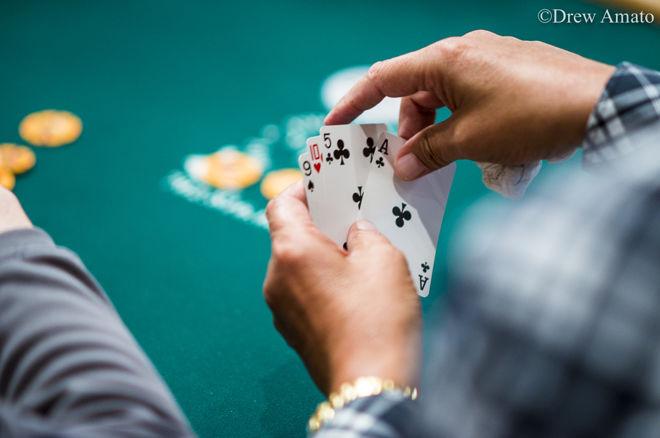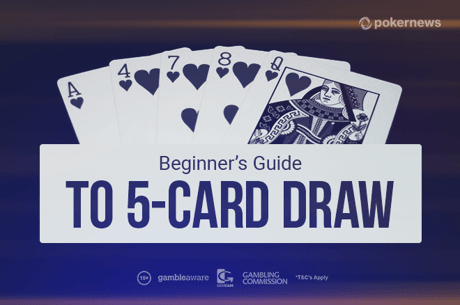WSOP Mixed Games Strategy: Limit Omaha Hi-Lo Split (Eight-or-Better)

Ed. note: The 2018 World Series of Poker is fast approaching. In order to get ready, over the next few weeks we're again sharing author Ken Lo's strategy advice for games other than no-limit hold'em.
With the World Series of Poker approaching, thousands of poker players around the world are preparing to converge at the Rio All-Suite Hotel & Casino in Las Vegas to take their shot at fame and fortune.
If you're one of those players who dreams of taking a shot at a WSOP bracelet, but no-limit hold'em is not your best game, then you're in luck — nearly half the events on the WSOP schedule involve games other than NLHE. It truly is the World Series of Poker, not just the World Series of No-Limit Hold'em!
In fact, the WSOP is one of the few live tournament series in which players are given the opportunity to test their skills in a wide range of variants beyond NLHE, and it is the only series to offer nearly a dozen $10,000 Championship events in such disciplines.
However, if you're like most poker players today, you probably play NLHE exclusively and have yet to give learning other variants serious thought. That said, more and more no-limit hold'em players are starting to realize the value of picking up new games — benefits that go beyond increasing one's chances of taking home a bracelet.
First, the added flexibility that comes with being able to play different games can help to combat hold'em fatigue and boredom. More importantly, becoming competent in other forms of poker will allow you to expand your "arsenal" of poker skills, and represents a critical component in becoming a well-rounded player.
If you envision yourself playing poker far into the future, yet you're not sure whether it's worth committing the time and energy to learning new games now, I'd encourage you to imagine what the poker landscape will be like in the next three, five, or ten years. Can you be certain that NLHE will continue to grow and be the game of choice? Are you confident that NLHE is the game where you will maintain the strongest edge over your opponents?
There really is no better time than now to start expanding your repertoire. By making the effort to learn new variants, you will not only be taking a big step toward becoming a more versatile player, but you will also be making an important long-term investment in your poker career.
Over the next few weeks, I'll be discussing some of the non-NLHE variants featured on the WSOP schedule. If a game piques your interest, think about taking some time to explore it further. Who knows — you just might find a new game to love!
Limit Omaha Hi-Lo Split (Eight-or-Better)
Limit Omaha Hi-Lo Split Eight-or-Better, often referred to simply as Omaha Hi-Lo or "O-8" (pronounced oh-eight) for short, is likely the most popular variant in live play behind NLHE and pot-limit Omaha.
Omaha Hi-Lo is also played in most multi-variant events, such as H.O.R.S.E. and other mixed-game format, and it's additionally an option in the Dealer's Choice events. It's also played in conjunction with Stud Hi-Lo Eight-or-Better (the "Mixed Omaha Hi-Lo/Seven Card Stud Hi-Lo" event).
The object of Omaha Hi-Lo is to make the highest five-card high hand, the lowest qualifying five-card low hand, or both. The Ax can play both as a high card and as a low card (e.g. as "1").
Omaha Hi-Lo is a "split-pot" game, meaning that two or more players holding different hands can each win a portion of the pot. When the pot is split, half the pot is awarded to the best HIGH hand, while the other half is awarded to the best qualifying LOW hand. A qualifying low hand is one consisting of five different low cards ranked eight or lower. In the event no player can make a qualifying low hand, the best high hand will win the entire pot.
Omaha Hi-Lo bears some resemblance to hold'em and pot-limit Omaha in that it is also a community card game where players are dealt a number of hole cards, and the board will contain a flop, turn, and river. Also, like PLO, each player is dealt four hole cards instead of two, and you must use exactly two hole cards when constructing a five-card hand.
For example, if the board is K♠3♣5♦K♦6♣, and you hold A♣4♥7♣K♣, you will be able to make the following hands:
- For the high hand: the 7♣ and 4♥ in your hand play, going with the 3♣5♦6♣ from the board to form a straight. Note you do not have a club flush — even though there are five clubs between the cards on the board and those in your hand, you cannot form a flush using EXACTLY two cards from your hand and EXACTLY three cards from the board.
- For the low hand: the A♣ and 4♥ in your hand play, going with the 3♣5♦6♣ from the board to make a 6-high hand (6-5-4-3-A). The pairings A♣7♣ or 7♣4♥ from your hand will not play when constructing the low hand, as they would both result in a worse 7-high hand compared to the lower-ranking 6-high hand that can be made by playing A♣4♥.
Hand Rankings
Standard poker hand rankings are used for the high hand. With respect to the low hand, recall that you are trying to make the lowest-ranked low hand; therefore, a five-card 8-high hand will be beaten by any 7-high (or lower-ranked) hand; a 7-high hand will be beaten by any 6-high (or lower-ranked) hand; and any 6-high hand will be beaten by a 5-high hand. A 5-high hand is the best low hand, and is commonly known as a wheel.
- 5♦4♦3♠2♥A♣ — 5-high hand = a wheel = the "nut" low hand
It is important to remember that with respect to low hands, Omaha Hi-Lo employs a qualifier: only 8-high or lower-ranked hands constitute qualifying low hands (this is why the name of the game includes the phrase "Eight-or-Better").
Reading low hands in Omaha Hi-Lo can be challenging for newcomers. To facilitate the reading of low hands, consider ordering the five cards used to form the hand — that is, the two hole cards and three community cards used — from highest rank to lowest. Then think of the sequence of ranks forming a five-digit number: the lower the number, the better the low hand.
Example:
- 8♠6♣4♦3♥2♥ = 86,432
- 7♦5♦3♣2♣A♠ = 75,321
Since 75,321 is the lower number, 7♦5♦3♣2♣A♠ is the better low hand (7-5-3-2-A).
Example:
- 7♠5♣4♦3♥2♥ = 75,432
- 7♦6♦3♣2♣A♠ = 76,321
Since 75,432 is the lower number, 7♠5♣4♦3♥2♥ is the better low hand (7-5-4-3-2), despite the fact the other hand contains the A♠, which is the lowest-ranked individual card.
This is why cards should be ordered from highest to lowest, to ensure the hand is read correctly. In this latter example, it is the second-highest card that breaks the tie, and since the five has a lower rank than a six, the hand headed by "7-5" will beat the hand headed by "7-6" for the low hand portion of the pot.
Play of the Hand
In Omaha Hi-Lo, there are four betting rounds, similar to NLHE. However, unlike NLHE and PLO, the amount that can be bet or raised on each betting round is fixed in the limit version of Omaha Hi-Lo. This means there is a "low limit" bet associated with the first two betting rounds (preflop and flop), and a "high limit" bet associated with the last two (turn and river).
For example, in a game with limits identified as "100/200" all bets in the first two betting rounds must be in increments of 100 (i.e., bet 100, raise to 200, reraise to 300, and so on), and all bets in the last two betting rounds must be in increments of 200 (i.e., bet 200, raise to 400, reraise to 600, and so on).
Basic Strategy Tips for Omaha Hi-Lo
1. Since everyone has been dealt four hole cards instead of two, players will generally be able to make stronger hands relative to NLHE.
In Omaha variants, since each player is dealt four hole cards, six different two-card combinations can be formed with each starting hand. When there are multiple players contesting the pot, the chances at least one player will hold some combination of cards that will connect very strongly with any given board is high.
Be particularly careful when holding a mere overpair, or when holding similar hands that have not connected strongly with the flop, particularly in multi-way situations.
For example, on a coordinated flop of 3♥4♥5♠ an overpair is much less likely to be good facing two or three opponents in an Omaha variant than it would be in NLHE. This is especially the case since many players will be playing starting hands concentrated in low cards. In particular, you should fully expect that at least one opponent in a multi-way pot might hold the highly coveted Ax2x holding for a flopped straight along with the nut low hand, possibly along with the nut flush draw.
2. A starting hand containing Ax2x is valuable for its potential to make nut low hands, but the hand can still be marginal if it lacks other helpful supporting cards.
If a flop contains two or three qualifying low cards other than an Ax or a 2x, a hand containing Ax2x will always provide the best low hand or draw.
For example, on a board of 4♣7♥8♦, any player holding Ax2x will have the best possible low hand (8-7-4-2-A). Note that 8-7-4-2-A is better than 8-7-4-3-A (made with Ax3x), 8-7-4-3-2 (made with 3x2x), or 8-7-5-4-A (made with Ax4x), as examples.

Therefore, while low holdings such as 3x2x, 4x2x, 5x3x, and the like may look decent at first glance, they often contribute to second-best or worse low hands in multi-way pots.
Even Ax3x and Ax4x can be troublesome since they can be dominated by the Ax2x holding for the low hand, but a starting hand containing Ax3x or Ax4x may have greater playability if the hand also provides for some flexibility with respect to the high hand (e.g., when the ace is paired, suited, or accompanied by a face card).
However, despite the star potential of the Ax2x holding, when the board happens to contain an ace or deuce and a low hand or draw is possible, the value of the Ax2x hand decreases significantly. Hands that would otherwise have been mediocre for the low hand portion of the pot can be elevated in status.
For example, if you hold Ax2x and the flop happens to contain an ace such as A♠5♣7♠, the player holding 3x2x (to make a low hand of 7-5-3-2-A) will now hold the best possible low hand thus far. And, depending on the other cards in your hand and the number of opponents involved, you could be left with a mere pair of aces and a tenuous holding for the high hand at best.
Since the appearance of an ace or a deuce on the board can adversely affect the ability of an Ax2x holding to make strong low hands, a backup low card, such as a trey or a four, to go along with an Ax2x holding, is extremely valuable. This will provide some insurance against the possibility that an ace or a deuce will appear on the board to nullify your low hand, which can be especially painful if it happens on the turn or river after you thought you had the low hand portion of the pot locked up on the flop (when that happens, your low hand is said to be "counterfeited").
3. Tight play will generally be rewarded in pots that can be expected to be contested multi-way. However, adjustments will usually be warranted when play is short-handed, or in potential steal situations.
Holdings that include at least one Ax and a 2x and in which all four cards work together to make multiple, strong two-card combinations (that might be playable to make very strong low or high hands), represent excellent starting hands. However, there are certainly situations where loosening starting hand requirements will be justified.
For example, in short-handed matches, or in steal situations, you can expect opponents to hold strong starting hands less often. Therefore, second-to-nut and third-to-nut hands — whether for the low or high hand — are more likely to be sufficient to win at showdown.
Furthermore, in heads-up situations, when you manage to make a decent hand for both halves of a pot that is likely to be split, it will be rare for your opponent to hold the perfect combination of hole cards that will allow him or her to win the entire pot.
Starting hands containing Ax3x, Ax4x, and even Ax5x become more playable in these situations, as they can make hands low enough to win the low hand portion of the pot, while simply pairing the ace may make a sufficiently competitive high hand. Suited aces and supporting Broadway cards can also add significant value to these starting hands.
Ken Lo is the author of A Poker Player's Guide to Mixed Games: Core Strategies for HORSE, Eight-Game, Ten-Game, and Twelve-Game Mixes, He is based in Toronto, Canada. Follow him via the book's Facebook page and on Twitter @ppgmg.
In this Series
- 1 WSOP Mixed Games Strategy: Limit Omaha Hi-Lo Split (Eight-or-Better)
- 2 WSOP Mixed Games Strategy: Razz
- 3 WSOP Mixed Games Strategy: No-Limit 2-7 Single Draw
- 4 WSOP Mixed Games Strategy: Deuce-to-Seven Triple Draw
- 5 WSOP Mixed Games Strategy: Badugi
- 6 What is Dealer's Choice Poker? 20 Different Games (Finally) Explained









